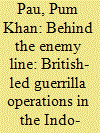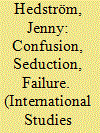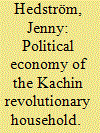|
|
|
Sort Order |
|
|
|
Items / Page
|
|
|
|
|
|
|
| Srl | Item |
| 1 |
ID:
165194


|
|
|
|
|
| Summary/Abstract |
The paper probes the formation of local Levies among the indigenous hill people of the Indo-Burma frontier and their contributions to the British-led guerrilla operations during the Second World War. With the shift of the theatre of the Southeast Asian edition of the Second World War from the Lower Burma plains to the mountainous hilly terrain in the Indo-Burma frontier, the mode of warfare also changed. In the new terrain where conventional warfare was no longer suitable the British Indian Army resorted to guerrilla tactics largely with the support of the indigenous hill people who had the traditional expertise in guerrilla fighting. However, the valour and heroism of the indigenous hill people behind the enemy lines has not received adequate scholarly attention. This paper discusses the case of three ethnic communities in the Indo-Burma frontier – Kachin, Naga and Zo (Kuki-Chin) – who were considered by the British as ‘loyal allies’ at the risk of Japanese atrocities. Supervised by British civil and military officers the local Levies not only effectively bogged down the Japanese forces in the frontier but also supplied valuable intelligence to the Allied force in the reconquest of Burma. The paper argues that Kachin, Zo and Naga rallied behind their colonial masters with the hope that they would receive reward from the latter after the war.
|
|
|
|
|
|
|
|
|
|
|
|
|
|
|
|
| 2 |
ID:
170368


|
|
|
|
|
| Summary/Abstract |
This article highlights the influence of emotions, affective experiences, and rumors on the construction of knowledge within research on conflict and in international politics, as well as within the research process itself. Drawing from fieldwork undertaken in a conflict zone in Myanmar, it suggests that academic knowledge production practices are informed both by the (violent) context in which research is undertaken and by the demands of the discipline to produce a scientifically accepted piece of research. It proposes that attention to emotions may facilitate strong objectivity (Harding 1992) by foregrounding the relationship between research participants, researchers, and the broader research (institutional and immediate) contexts. It introduces the term “rumors-as-affect” as a means to discuss how affective atmospheres or events in the research environments inform research. Three interview situations are presented, in which different emotional reactions are highlighted, focusing on “confusion and guilt”; “seduction”; and finally, “failure and ignorance.” These events illustrate how, in recognizing the role emotions and affective atmospheres play in research on conflict and in international politics (cf. Crawford 2014; Hutchison and Bleiker 2014; Ross 2013), researchers may begin to do justice to our representations of what is encountered in the field and how knowledge is constructed within the discipline.
|
|
|
|
|
|
|
|
|
|
|
|
|
|
|
|
| 3 |
ID:
189363


|
|
|
|
|
| Summary/Abstract |
In 2011, Burma/Myanmar one-sidedly halted the billions-worth construction of Myitsone Dam, derailing China’s then-largest-ever hydroelectric project abroad and creating a lasting controversy in China–Burma relations. This decision followed an unprecedented public outcry in Burma and a decade of inter-ethnic resistance against this mega-project. This article explores how, throughout the Myitsone Dam controversy, actors at different scales and in three national societies speculated about hidden hostile inter-national plots behind the project or the resistance. Drawing on more than two years of ethnographic fieldwork in 2010–2019, interviews, and media analysis, this article takes seriously many Chinese, Burmese, and Kachin voices – from ambassadors and journalists, to activists and village elders – who claim or dispute various hidden hostile inter-national strategies. The Myitsone case shows how deeply inter-national speculating shapes Burma, often in ways that erase ethnic-minority actors, popular movements, or dispossession. More broadly, it shows how nationalist thinking and competing nationalisms can shape ideas about a frontier of resource extraction. Finally, ethnographic research has often revealed how marginalised people’s conspiratorial narratives can reflect realities, but this study suggests using ethnography to let people challenge dominant conspiracy theories about themselves. Researchers across ethnographic disciplines, International Relations, and critical geopolitics face the analytical and ethical challenge of both contextualising and evaluating any people’s claim that someone plots against them.
|
|
|
|
|
|
|
|
|
|
|
|
|
|
|
|
| 4 |
ID:
153250


|
|
|
|
|
| Summary/Abstract |
Applying a feminist political economy analysis of the Kachin military movement, this article will be mapping women's involvement in the armed uprising since the outbreak of the conflict in 1961, demonstrating the centrality of gender relations for the war. Using primary data, this article will show how the household provides essential support to the Kachin war effort in the shape of emotional, physical and material labour, thus underscoring the critical role played by women in maintaining the conflict. Examining the relationship between narratives of gendered insecurity in the community and notions of militarized duty, this article will argue that the Kachin armed forces have employed gendered notions of security and duty to legitimize and sustain the conflict. The importance of normative gender relations for providing labour and emotional and material support for the conflict will then be examined, showing how the household is situated as the nucleus of the armed revolution. The findings in this article thus reveal a need to take into account the relationship between the household and the armed conflict, arguing that the household is a site inseparably linked to nationalistic objectives, underpinning the economic and ideological structures of military movements. Interventions aiming at resolving the conflict in Kachin must therefore consider the importance of gender relations in upholding the political-economy infrastructure of the military movement.
|
|
|
|
|
|
|
|
|
|
|
|
|
|
|
|
|
|
|
|
|